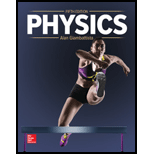
Concept explainers
(a)
The maximum height made by the locust at its jump.
(a)
Answer to Problem 101P
Maximum height is
Explanation of Solution
The jump of locust is a projectile motion.
The angle of jump is
At maximum height, the vertical component of velocity is zero. Write the expression for vertical component of velocity at the highest point of motion.
Here, the vertical component of velocity at the highest point is
Rewrite the above relation in terms of
Write the equation for horizontal distance covered by locust in time
Here, the horizontal distance covered by locust in time
Rewrite the above relation in terms of
Equate the right hand sides of equation (I) and (II).
Rewrite the above relation in terms of
Write the expression for the maximum height of a projectile.
Here, the maximum height is
Rewrite the above relation for
Conclusion:
Substitute
Therefore, the maximum height is
(b)
Check whether the maximum height would be smaller or larger if the locust jumps with the same initial speed at
(b)
Answer to Problem 101P
Maximum height would be smaller than that of in
Explanation of Solution
The jump of locust is a projectile motion.
The angle of jump is
Write the final equation for
From the above equation can be seen that
Conclusion:
Therefore, the maximum height would be smaller than that of in
(c)
Check whether the horizontal range of locust would be smaller or larger if the locust jumps with the same initial speed at
(c)
Answer to Problem 101P
Horizontal range would be larger than that at
Explanation of Solution
The jump of locust is a projectile motion.
The angle of jump is
Write the equation for the horizontal range of a projectile.
Here, the horizontal rage of projectile is
From the above equation can be seen that
Conclusion:
Substitute
Substitute
It is found that
Therefore, the horizontal range would be larger than that at
(d)
The maximum horizontal rage and height achieved by locust at
(d)
Answer to Problem 101P
Maximum horizontal range is
Maximum height is
Explanation of Solution
The jump of locust is a projectile motion.
Conclusion:
Substitute
Substitute
Substitute
Therefore, the Maximum horizontal range is
Want to see more full solutions like this?
Chapter 3 Solutions
Physics
- Rod AB is fixed to a smooth collar D, which slides freely along the vertical guide shown in (Figure 1). Point C is located just to the left of the concentrated load P = 70 lb. Suppose that w= 17 lb/ft. Follow the sign convention. Part A Figure 3 ft -1.5 ft √30° 1 of 1 Determine the normal force at point C. Express your answer in pounds to three significant figures. ΜΕ ΑΣΦ Η vec Nc= Submit Request Answer Part B Determine the shear force at point C. Express your answer in pounds to three significant figures. VC= ΜΕ ΑΣΦΗ vec Submit Request Answer Part C Determine the moment at point C. Express your answer in pound-feet to three significant figures. Mc= Ο ΑΣΦ Η vec Submit Request Answer Provide Feedback ? ? lb lb ? lb-ftarrow_forwardConsider a uniformly charged ring of radius R with total charge Q, centered at the origin inthe xy-plane. Find the electric field (as a vector) at a point on the z-axis at a distance z above thecenter of the ring. Assume the charge density is constant along the ring.arrow_forward3) If the slider block C is moving at 3m/s, determine the angular velocity of BC and the crank AB at the instant shown. (Use equation Vs Vc wx fuc, then use equation Vs VA + Ve/athen write it in terms of w and the appropriate r equate the two and solve) 0.5 m B 1 m 60° A 45° vc = 3 m/sarrow_forward
- 3) If the slider block C is moving at 3m/s, determine the angular velocity of BC and the crank AB at the instant shown. (Use equation Vs Vc wxf, then use equation V, VA + Va/Athen write it in terms of w and the appropriate r equate the two and solve) f-3marrow_forwardPls help ASAParrow_forwardPls help ASAParrow_forward
- 14. A boy is out walking his dog. From his house, he walks 30 m North, then 23 m East, then 120 cm South, then 95 m West, and finally 10 m East. Draw a diagram showing the path that the boy walked, his total displacement, and then determine the magnitude and direction of his total displacement.arrow_forwardPls help ASAParrow_forwardPls help ASAParrow_forward
- Pls help ASAParrow_forwardPls help ASAParrow_forward12. A motorboat traveling 6 m/s, West encounters a water current travelling 3.5 m/s, South. a) Draw a vector diagram showing the resultant velocity, then determine the resultant velocity of the motorboat. b) If the width of the river is 112 m wide, then how much time does it take for the boat to travel shore to shore? c) What distance downstream does the boat reach the opposite shore?arrow_forward
 College PhysicsPhysicsISBN:9781305952300Author:Raymond A. Serway, Chris VuillePublisher:Cengage Learning
College PhysicsPhysicsISBN:9781305952300Author:Raymond A. Serway, Chris VuillePublisher:Cengage Learning University Physics (14th Edition)PhysicsISBN:9780133969290Author:Hugh D. Young, Roger A. FreedmanPublisher:PEARSON
University Physics (14th Edition)PhysicsISBN:9780133969290Author:Hugh D. Young, Roger A. FreedmanPublisher:PEARSON Introduction To Quantum MechanicsPhysicsISBN:9781107189638Author:Griffiths, David J., Schroeter, Darrell F.Publisher:Cambridge University Press
Introduction To Quantum MechanicsPhysicsISBN:9781107189638Author:Griffiths, David J., Schroeter, Darrell F.Publisher:Cambridge University Press Physics for Scientists and EngineersPhysicsISBN:9781337553278Author:Raymond A. Serway, John W. JewettPublisher:Cengage Learning
Physics for Scientists and EngineersPhysicsISBN:9781337553278Author:Raymond A. Serway, John W. JewettPublisher:Cengage Learning Lecture- Tutorials for Introductory AstronomyPhysicsISBN:9780321820464Author:Edward E. Prather, Tim P. Slater, Jeff P. Adams, Gina BrissendenPublisher:Addison-Wesley
Lecture- Tutorials for Introductory AstronomyPhysicsISBN:9780321820464Author:Edward E. Prather, Tim P. Slater, Jeff P. Adams, Gina BrissendenPublisher:Addison-Wesley College Physics: A Strategic Approach (4th Editio...PhysicsISBN:9780134609034Author:Randall D. Knight (Professor Emeritus), Brian Jones, Stuart FieldPublisher:PEARSON
College Physics: A Strategic Approach (4th Editio...PhysicsISBN:9780134609034Author:Randall D. Knight (Professor Emeritus), Brian Jones, Stuart FieldPublisher:PEARSON





